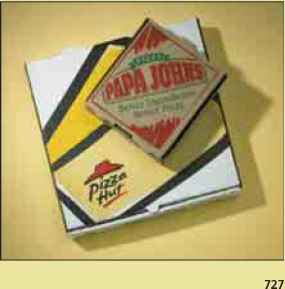The Pizza Wars Legal Battle Upholds the Use of Puffery
The use of unsubstantiated superlatives such as good, better, and best have long been a staple of American advertising. The Federal Trade Commission views the use of these terms,as well as other forms of marketing bravado, as puffery. The FTC defines puffery as "clear hyperbole" and takes the position that consumers would not expect these claims to be documented and would not take them seriously. However, a recent legal battle between Pizza Hut and Papa John's over the lat-ter's use of puffery nearly resulted in a redefining of the limits of advertising claims that would have opened a large can of worms for the entire industry.
In 1997 Papa John's began running ads comparing its product to market leader Pizza Hut and using the tagline "Better ingredients. Better pizza." The battle heated up in 1998 when Papa John's ran a series of ads designed to show just why it believed that better ingredients do indeed make a better pizza. One spot featured Papa John's brash founder, John Schnatter, claiming consumers preferred his chain's tomato sauce because Papa John's uses fresh tomatoes picked from the vine while Pizza Hut uses "remanufactured paste." Another spot explained that Papa John's dough is made with clear filtered water and yeast given several days to work its magic while the "biggest chain" (Pizza Hut) uses whatever comes out of the tap to make frozen dough or dough made the same day.
Pizza Hut responded with what it called a "corrective ad" on the dough issue and, after getting no sympathy from the National Advertising Division of the Council of Better Business Bureaus, filed a lawsuit against Papa John's in 1998 claiming that much of its advertising was false and misleading. The suit was heard in November 1999 and after weeks of testimony in federal court, which included dough experts and sauce demonstrations, a jury sided with Pizza Hut, ruling that Papa John's "Better ingredients. Better pizza" slogan was false and misleading because the chain had failed to prove its sauce and dough were superior. The judge in the case upheld the jury's decision and ruled that the slogan was acceptable puffery until Papa John's began running ads touting its tomato sauce and pizza dough as superior. He held that the slogan then became tainted to the extent that its continued use should be stopped. The judge admonished both sides for the dubious nature of their advertising, but ordered Papa John's to pay Pizza Hut $468,000 in damages and also issued an injunction against the entire "Better ingredients. Better pizza" integrated marketing blitz, including use of the slogan on store signage, pizza boxes, car toppers, menus, napkins, and hats as well as in advertisements.
In January 2000 Papa John's appealed the decision, arguing that the judge had misinterpreted the law as use of the "Better ingredients. Better pizza" slogan was legally acceptable puffery. The court of appeals handed down a complicated ruling that sided with Papa John's on the puffery issue and lifted the injunction. The appellate judges ruled that Papa John's ads were misleading but argued that Pizza Hut had not provided enough evidence that the misrepresentation was "material" and had a negative effect on consumers' purchase behavior. Pizza Hut was outraged by the ruling, arguing that as "evidence" it had produced three different consumer surveys at the original trial, all of which indicated that consumers were wrongly influenced by the Papa John's campaign. However, all three surveys were ignored by the courts on technicalities.
Pizza Hut continued to believe that if the judges felt the advertising was misleading, and their ruling said they did, they should have punished Papa John's. So, in December 2000, Pizza Hut's lawyers decided to appeal the case to the U.S. Supreme Court on the basis that the appeals judges had required an unusually high standard of evidence to prove that consumers had been misled by Papa John's. An attorney for Pizza Hut who argued the case before the Supreme Court stated: "There is no social value in false advertising, and the concept that you turn a blind eye to false advertising simply because of the inability to prove very precise purchasing decisions strikes me as a standard of proof that is extremely high and completely unwarranted." However, in March 2001 the Supreme Court handed down its two-word decision: "Petition

denied." The court of appeals ruling favoring Papa John's was allowed to stand.
Despite being disappointed at losing the case, Pizza Hut's general counsel was philosophical about the ruling, noting that it trapped Papa John's in a curious catch 22: If Pizza Hut won, it could describe Papa John's advertising as false; but if Papa John's won, it would be only because it had successfully argued that its advertising was mere puffery—not to be believed — which is exactly what happened. Papa John's expressed satisfaction with the case and indicated that it was glad the matter was over—and for good reason. The company's financial reports indicated that it had spent at least $7 million to cover the legal costs of the case. Experts noted that it is reasonable to assume that Pizza Hut incurred similar costs.
The advertising industry was also relieved that the Supreme Court had ruled in favor of Papa John's. The case had put many executives on edge, as a ruling against the puffery defense could have prompted other challenges and a redrawing of the blurry line separating so-called puffery and outright false advertising. With this ruling, advertisers are still free to use words such as good, better, and best and let consumers determine what they really mean.
Sources: Jim Edwards,"Sour Dough: Pizza Hut v. Papa John's," Brandweek, May 21,2001, pp.26-30; Davan Maharaj and Greg Johnson,"Battle over Pizza Puffery Could Reshape Ad Landscape," Los Angeles Times, Apr. 2,2000, pp. Cl, 4; Michael Fumento,"Free-a-the Papa!" Forbes, Feb.21,2000, p. 53; Louise Kramer,"Jury Finds Papa John's Ads Misled," Advertising Age, Nov. 22,1999, p. 46.
Continue reading here: The Brave New World of Advertainment
Was this article helpful?


